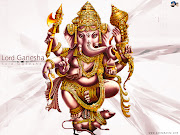Birth of Ganesh and some history
Ganesha (and Skanda too) is understood to be the first God in that sense that if someone
wants to come up to Shiva, he must first get through the Ganesha's
doorstep.
He is mentioned in the oldest Veda - Rig Veda.
Ganesh was born on the fourth day in the Hindu month Magh and He has many powerful
aspects. He is also considered to be the master of astrology. According
to the Hindu calendar of religious events, His birthday is celebrated
in August/September, and this date is variable similarly like Christian
Easter (based on the lunar calendar). Hinduism consists of four basic
(mainstream) branches of which shaivism is the oldest one. Hence,
God Shiva is the absolute God; in other Hindu denominations it is
Shakti (female principle) - shaktism, Vishnu and His avatar
(incarnation) Krishna - vaishnavism.
Smartism is a school that follows Smriti - a specific canon
of Hindu religious scripture.
In Hinduism, mainstream Vaishnava, Shakta and Shaiva
schools are well-documented, but they also have their offshoots. Cults
of sUrya, skAnda and gAnApAtyA are poorly documented. Ganesh, while
being one of the most extensively worshiped deities of the Pan Hindu
religion, is one of the most poorly understood ones in terms of origins
and history. The sectarian worship of Ganapati and Kumara is
principally extinct. The literature and practices of these cults are
also largely unknown to most Hindus.
Some words about Buddhism
In esoteric Buddhism, Ganesh in Japan is pictured as a Twin-God - two figures joined to one, often with sexual connotation. These statues are not seen publicly. In Japan, there are more than 250 temples dedicated to Lord Ganesh and He has names such as Kanki-Ten, Kangi-Ten, Shooten, Vinayaaka, or Daishoo Kangiten. In Kamakura (a city in Japan), there is a temple (Hookaij-Ji) with allegedly the oldest statue of Ganesh in Japan; it is locked and supposed to have been preserved locked there from the year 1333. The Twin God is nanten - male, nyoten - female Ganesha. It also represents His/Her ego.
Many historians date the presence of Ganesh in Japan back to times when a great monk - Kukai (774- 834) - started the Shingon sect in Japanese Buddhism. The means of worshiping Ganesha, Ganabachi, Vinayaka or Kangiten embody something that makes this cult different from other Buddhist streams. The teaching, rituals and beliefs of the cult have many parallels with the cult of Ganapatyas
In Ganesha Purana it is written:
At His command Lord Brahma creates the universe. At His command Lord Visnu maintains the universe. At His command Lord Siva destroys the universe. At His command the Sun, Lord of the day, moves throughout the universe. At His command Vayu directs the wind. At His command Varuna causes the waters to flow in all directions. At His command the stars shine in the sky. At His command Agni burns in the three worlds...
Symbolism of Ganesh
Ganesha is the first sound, OM, in which all hymns were born. When Shakti - (Energy) and Shiva (Matter) meet, Sound (Ganesh) and Light (Skanda) are born. The number FOUR is the principle message of swastika. Ganesha's head symbolizes atman. His big body represents the earthly existence of humankind, but also maya - "illusion of this world". His elephant head indicates that He is the wisest and most powerful Being among animals; His wide ears indicate that He is able to hear anything in the universe...
This God wrote Mahabharata as a scribe when the sage Vyasa dictated this old Indian epos to Him. He has a trident on His forehead, which some authors consider to be a link to Atlantis, as it is also Poseidon's symbol (Greek god of the sea).
Swastika is in His right hand; the mouse at the bottom of His body indicates that He can get secretly anywhere.



Post a Comment